Essay On Clouds (Structure/Outline)
- Introduction
- Formation of Clouds
- Types of Clouds
- Global Distribution of Clouds
- Effects of Clouds
- FAQS

Introduction
Clouds are masses of tiny water droplets or ice crystals suspended in the atmosphere. They can range in size from small stripes near the horizon to large towering regions of turbulent cumulonimbus clouds that may produce lightning and thunder. Clouds come in a variety of shapes and sizes, each signifying a different type of cloud – from lofty cumulus clouds shaped like billowing mountains to the subtler cirrus wisps that look like they were made by a painter’s brush swooping across the sky. The definition and types of clouds have been studied since ancient times and remain one of nature’s most beautiful and fascinating features.
Formation of Clouds
Clouds form when air is cooled to the point where it can no longer hold all of the water vapor in it. When this happens, the water vapor starts to condense into tiny droplets that form clouds. The most common way for air to become cooler is by ascending.
As air rises, it expands and cools, and if it cools below its dew point, clouds will form. This is why you often see clouds along mountain ridges or other high points. Clouds can also form when air is cooled near the ground, such as during the night when temperatures are cooler than during the day.
Clouds form in the sky when moisture in the atmosphere lifts high enough to reach cooler temperatures, condensing and forming droplets of water. Starting from a tiny droplet, these can work together with other droplets to create rain or snow.
The amount of water vapor required for cloud formation as well as the altitude at which it condenses differ depending on various factors, but generally requires air in the upper parts of Earth’s atmosphere that are very cold and saturated with humidity.
As the droplets grow bigger within the formation of a cloud, they will eventually pass their point of saturation and release their water onto the ground, making way for new clouds to form anew.
Types of Clouds
Clouds come in a variety of shapes, sizes, and colors. These can be classified as follows.
(a) Classification According to Altitude level
(1)High-Levell Clouds:
These clouds usually form in the upper atmosphere, at heights of 20,000 feet or higher. This type of cloud generally consists of thin, feathery cirrus clouds that appear white and wispy.
(2)Middle-Level Clouds:
Generally found between 6500 to 20000 feet above sea level, middle-level clouds are made up of cumulus and stratocumulus clouds. These are the most recognizable clouds in the sky, with their puffy white shapes that look like cotton balls.
(3)Low-Level Clouds:
Forming between ground level to 6500 feet above sea level, these clouds consist of nimbostratus and stratus clouds. They have a flat appearance and tend to be dark grey or black.
(b) Classification of Clouds According to their Motion
(1) Cumulus Clouds:
These are the fluffy, white clouds that resemble cotton balls. They tend to be stationary and can form anywhere from a few hundred feet above ground level up to 20,000 feet in the atmosphere.
(2) Stratocumulus Clouds:
Stratocumulus clouds have an arrangement of lumpy, white patches that often appear in rows. The clouds tend to stay close to the ground and are frequently seen near the horizon with a blanket-like appearance in the sky.
(3) Cirrus Clouds:
These high-level clouds are made up of thin, feathery wisps that can be seen in all directions. Cirrus clouds are often associated with fair weather and appear when the atmosphere is stable and dry.
(4) Stratus Clouds:
Stratus clouds are low-level formations that generally have a uniform, grey color. They can be seen near the horizon or as an even layer of fog over the landscape.
These clouds often produce a light mist or drizzle.
(5) Nimbostratus Clouds:
Nimbostratus clouds are dark, low-level formations that bring continuous rain or snow over an area. They can be seen at any time of day and form when moist air is lifted to cooler altitudes in the atmosphere.
The formation and types of clouds play an important role in weather patterns, climate, and temperature across the world. It’s amazing to think that something as seemingly simple as a cloud can have such a huge impact on our day-to-day lives!
Learning about different types of clouds is a great way to get outside and explore the ever-changing sky. It’s also a great way to get to know our atmosphere better and observe how weather patterns change over time.
Global Distribution of Clouds
Clouds are found all over the world, but they can vary significantly in their formation and distribution based on location. In general, clouds form more commonly at the equator than in other regions due to the higher temperatures present there.
The highest concentrations of clouds occur near large bodies of water, such as oceans and lakes. This is because the air over these areas is more likely to be humid, leading to greater condensation and cloud formation. As you move farther away from the equator and closer to the poles, clouds become less common due to cooler temperatures and drier air.
Clouds also tend to form differently depending on what type of terrain they are over. In mountainous regions, clouds will form at various levels due to wind turbulence and the rising of warm air currents.
This can lead to a wide variety of cloud types appearing in one location, as different elevations create different conditions for condensation. Similarly, clouds will form differently over flat terrain, as the air is not likely to rise and create turbulent winds. The types of clouds that form over different terrains can tell us a lot about the local climate and weather conditions.
Effects of Clouds
(1) Effect On Climate
Clouds can have both a positive and negative effect on climate. On the one hand, clouds can reflect sunlight into space, cooling down the atmosphere and helping to regulate temperatures. On the other hand, cloud cover can trap heat from the sun in the atmosphere, leading to an increase in temperature due to this trapped heat. Because of this, scientists are constantly observing clouds and their effects on climate to better understand the complexities of our atmosphere.
(2) Effect On Precipitation
Clouds are responsible for bringing us precipitation such as rain, sleet, and snow. When tiny water droplets condense on particles in the air, they form clouds which can then become heavy and fall to the ground in the form of rain, sleet, or snow. Thus, clouds are essential for bringing us this valuable source of water!
(3) Effect On Visibility
Clouds can also affect visibility by blocking out light from the sun, resulting in a darker sky. This is especially true during overcast days when clouds completely cover the sky and block out any rays of sunlight. On very cloudy days, this can reduce visibility significantly, so it’s important to be aware of your surroundings if you plan to be outdoors.
Clouds are an incredible part of our atmosphere that have a wide variety of effects on our lives and environment. Understanding how clouds form, their global distribution, and the effects they have on our climate is essential for appreciating their beauty and importance in nature.
FAQS
Why are clouds important?
Clouds are important because they reflect sunlight \into space, help regulate temperatures, and bring us precipitation such as rain, sleet, and snow. Without clouds, our environment would be much different!
Where are clouds found?
Clouds can be found all over the world but their distribution varies based on location. In general, higher concentrations of clouds occur near large bodies of water, such as oceans and lakes.
Which clouds bring rain?
Rain clouds are typically formed from tiny water droplets that condense on particles in the air. When these droplets become heavy enough, they will fall to the ground in the form of rain, sleet, or snow.
Why are clouds dark?
Clouds can appear dark when they block out light from the sun, especially during overcast days. This is because clouds absorb and reflect sunlight, resulting in a darker sky with reduced visibility.
Essay On Clouds (Pictures & PDF)
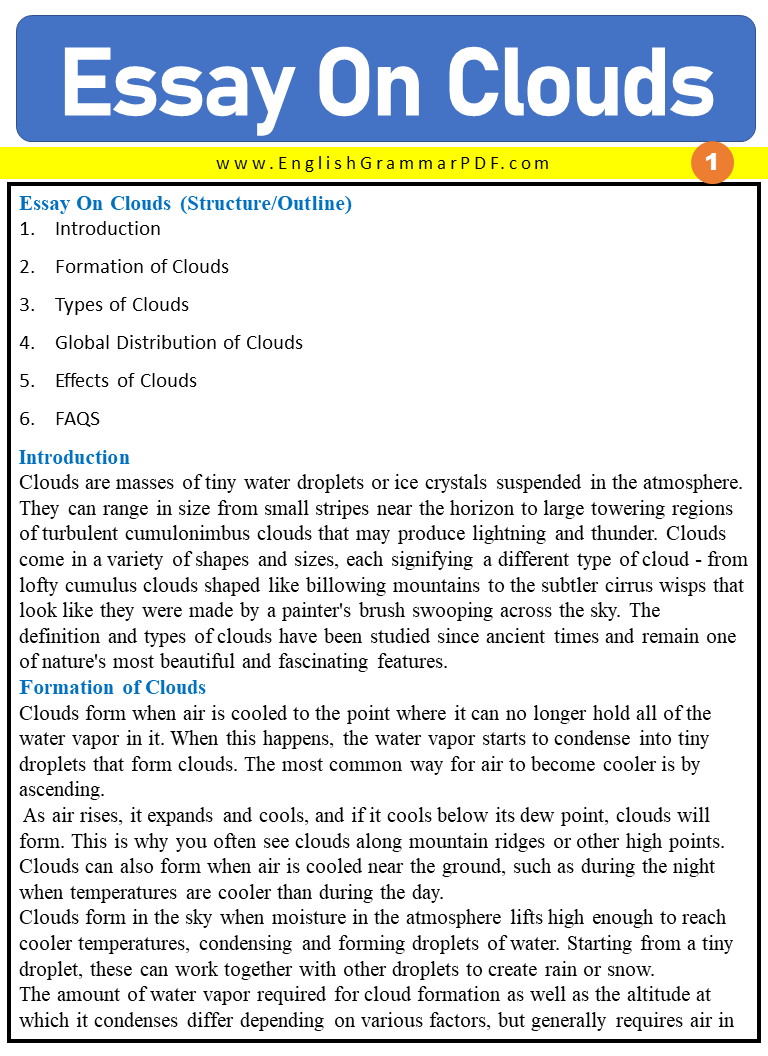
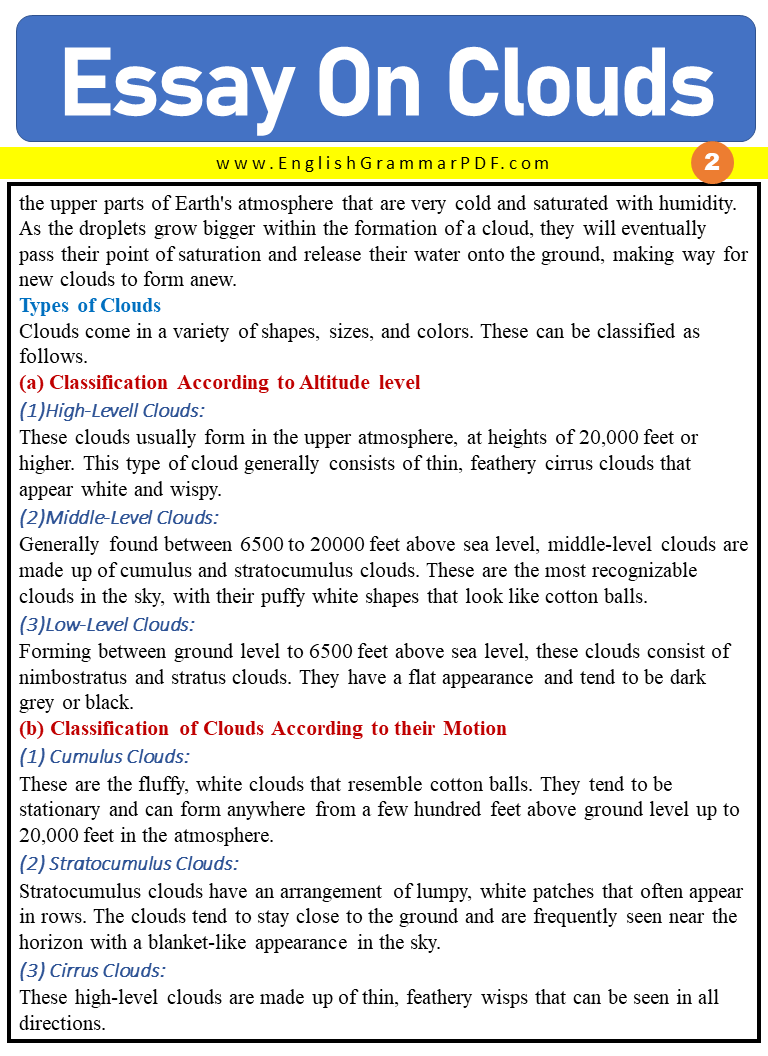
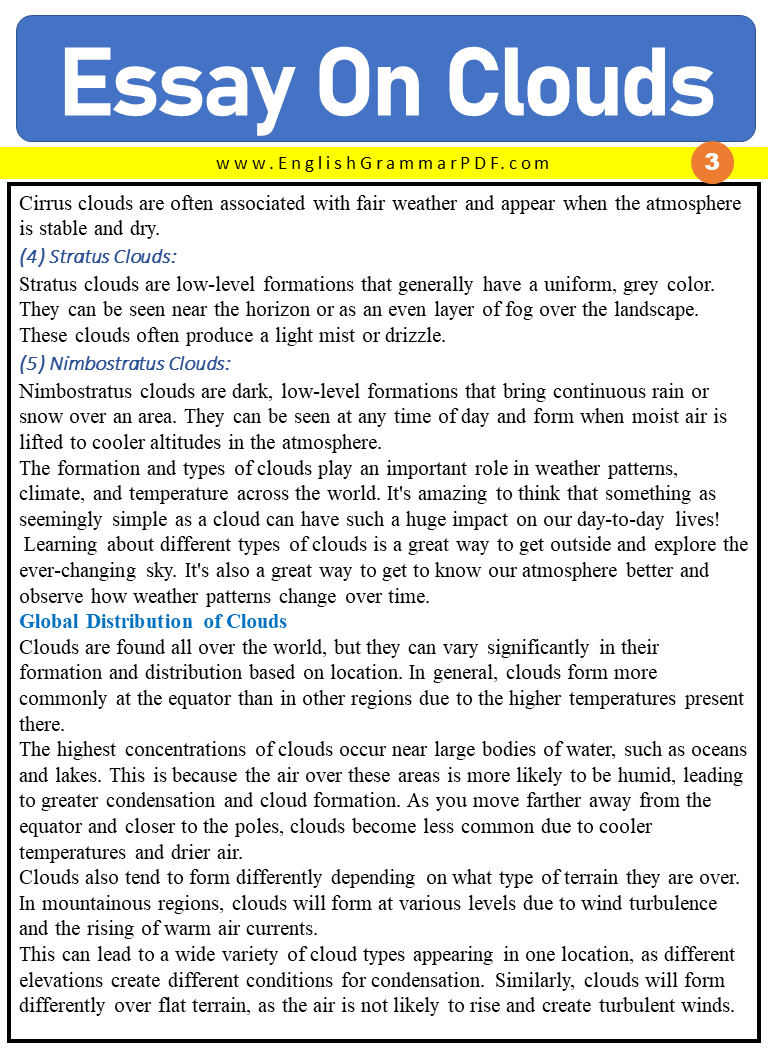
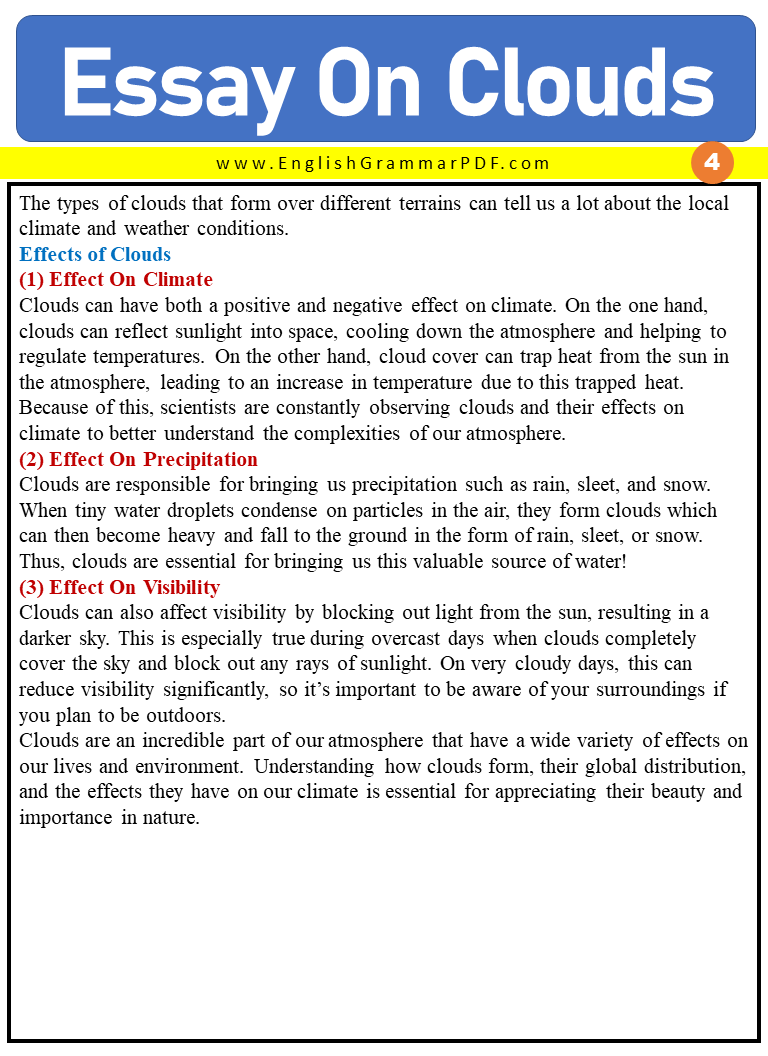
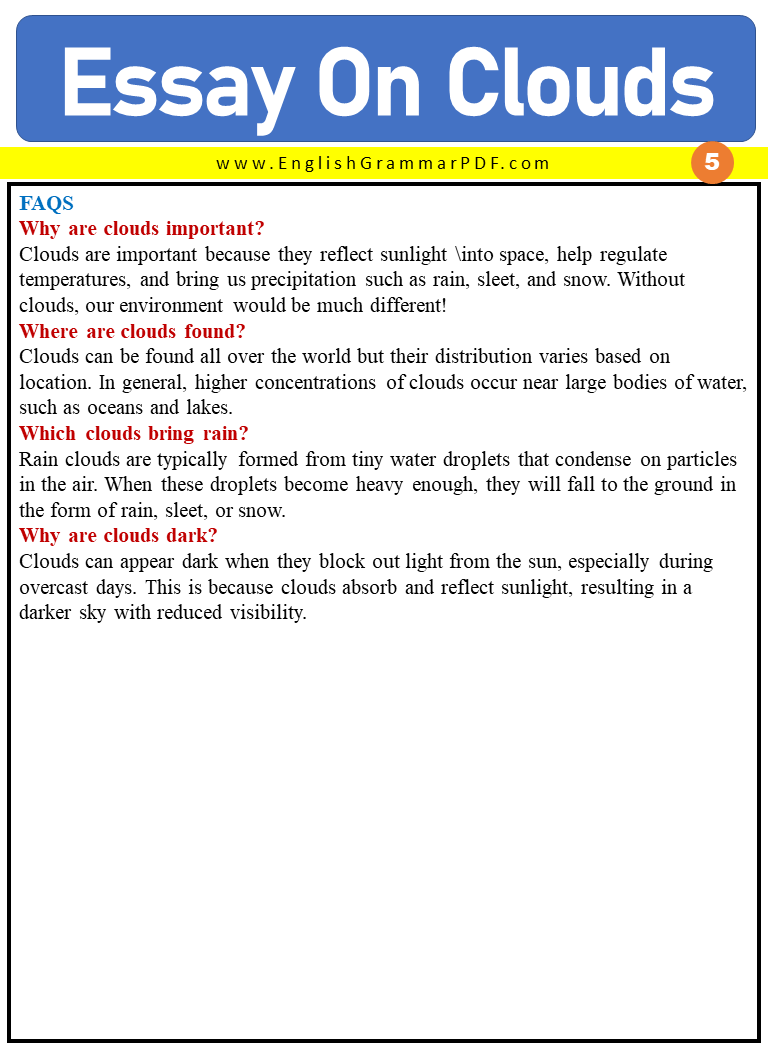
Related: Essay on China
Below is the PDF of this Essay.


